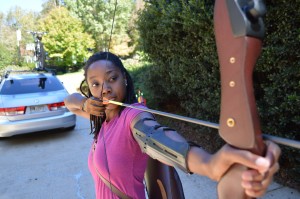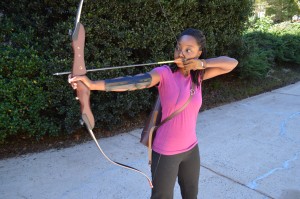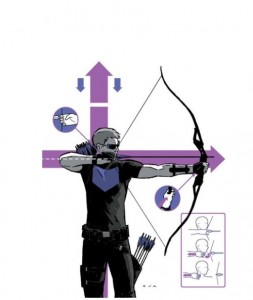 Good form isn’t a matter of pointless rules and baseless traditions. Developing good form in archery encourages consistency, which is precisely what you need to aim true again and again.
Good form isn’t a matter of pointless rules and baseless traditions. Developing good form in archery encourages consistency, which is precisely what you need to aim true again and again.
As I’ve mentioned before, I’m a beginner and I’m not some sort of natural-born prodigy. The tips that I’m passing to you are what I’ve learned from my coach! Hopefully they’ll help you get started.
I’m dividing the pointers into sections but please be aware that as you become more comfortable, many of these actions may happen simultaneously.
Stance
Stand perpendicular to your target so that your bow arm is facing the target. Keep your feet about hip-width apart. It’s recommended to stand with you feet parallel to each other but this feels incredibly unnatural to me and several others so I tend to stand with my hips “open,” the foot closest to the target turned out a few degrees.
Upper Body
Distribute your weight evenly, left, right, back and front. Pull your shoulder blades together just enough so that your chest doesn’t concave but you don’t want your back to arch like a gymnast either. Think about being tall and stable.
You’re ready to get going! Load your arrow at its knocking point and be sure that it’s resting securely on the arrow rest.
Hands
Bow hand: Hold the bow just tight enough to secure it. There is no need to strangle the riser. (After releasing the arrow, your bow may want to tilt forward a bit; let it. This is the equivalent of following-through with a baseball bat or golf club.)
Arrow hand: For beginners here in the States, it is often recommended to draw using your index, middle, and ring fingers. Place those fingers under the knocking point. As you raise the bow to aim, you should be slowly drawing the string back and finding your anchor point. As you draw, keep your knuckles flat. A ruler should be able to lay flat across your knuckles, wrist, and forearm.
Anchor point: The is a point that your arrow hand will come to repeatedly as you approach full draw. For me, the knuckle of my index finger just comes to the corner of my mouth; this also means that the corner of my jaw rest in the crook between my thumb and index finger. Find an anchor point on your face that’s comfortable for your body and be consistent!
Arms and Shoulders
If we were to take your picture at full draw, the elbow of your arrow hand would be on a slightly higher plane than the your extended bow arm. Avoid hitching up that elbow at a steep angle. Both arms should be parallel to each other. (In the picture above, I’m leaning back a bit. That’s a no-no. But otherwise the form is pretty good.)
At first, many of us naturally tense up at full draw. Try to relax you shoulders, gently pressing them downward if they’re raised up towards your ears, like a shrug. Your back should support your arms and the bow rather than expecting your arms and shoulders to do all of the work.
Your bow arm should be well-supported but relaxed. Try not to make your arm rigid. If you tend to hyperextend your elbows when straightening your arms, it can even be beneficial to keep a micro-bend in your elbow. This will keep your arm from being too tense and prevent string slap, which leaves nasty bruises.
I found the diagram below on Tumblr. It’s helpful but, unfortunately, there isn’t a credit. (If you know who created it, please let me know!)

Aiming
There are a million recommendations for aiming based on whether you’re using a sight or not. I shoot bare bow, so you may come across different guidelines if you’re using a sight and other accessories. The following tips for adjusting your aim will work for everyone, though.
In the beginning, my coach advised placing the tip of the arrow at the center of the target to aim. I shot several arrows this way until a pattern emerged; I consistently clustered to the top left of center. So to adjust, I began aiming to the bottom right of center and my clusters have improved. When you make adjustments, you’ll want to go in the opposite direction of your undesired pattern. Start making teeny-tiny changes at first and shoot several arrows after each change to get an idea of how the adjustment affects you. You won’t get a good reading with one arrow, or if you change multiple aspects of your form at once.
Troubleshooting
If your shoulders hurt- First, make sure that you aren’t too tense. To actively relax, think about lower your shoulders and bringing your shoulder blades a bit closer together. If that doesn’t help after several sessions, it could be that you aren’t actively engaging your core and back. This is a tough lesson to learn and even harder to explain but try to pay attention to your core and back muscles as you draw. Does your belly feel loose and sluggish? Are you leaning in one direction or another?
If you’re leaning back- If you feel you must lean back when you draw, you could be overbowed, meaning that the draw weight is too heavy for you. Select a bow with a lighter draw weight or loosen your compound bow string by 1/4 turn. Sometimes people also lean back because they think it makes them look more powerful and badass. It doesn’t. So don’t do it.
If your fingers hurt- If it’s cold outside and you’re shooting a lot with your fingers, there is little you can do about achy fingers. You’ll just get used to it. If you prefer, consider using a glove, finger tabs, or a release. Many people say a release improves accuracy as well as comfort.
If you get cramps in your bow hand- You’re probably squeezing the riser too hard. Relax the muscles in that hand. If your subconscious keeps telling you the bow is going to fall or fly away, get a wrist sling. There is also a chance that the riser itself is a poor choice for your hand (too narrow or too broad). If you have a takedown recurve bow, then you can get a riser in a different width. Otherwise, you can try padding a narrow riser the until you get a bow that fits you better.
Hopefully this helps other beginners. If you’re a more advanced archer, your tips and feedback are welcome!
Hello, We have just started practising archery in Ghana. We need some support in the form of a coach coming over to teach beginners. We are also looking for an Archery Club to collaborate with so we can get some additional equipment for our people. Can you link us to some people who may be interested?
I love how you can describe this to make sense for all the beginners! My sister said it made sense and she has never even shot before! Love your advice!
Awesome! I’m so glad that this could be helpful for you and your sister. Happy shooting!
Most of the instructors that I know are located locally and I’m not sure about their availability to travel internationally. You may want to reach out to them individually.
I trained here:
Archery Learning Center
But you may also try here:
2nd Change Archery
Learn Archery
Thank you for the information. In case you come across any trainers interested in coming to Ghana please let us know.